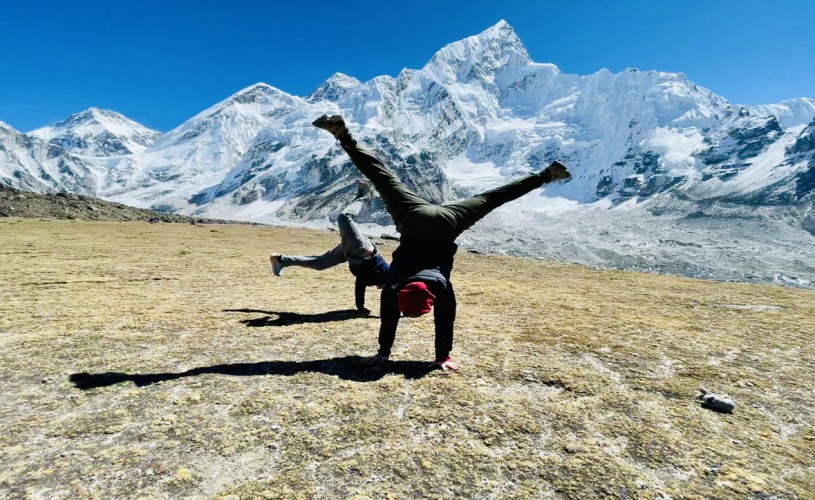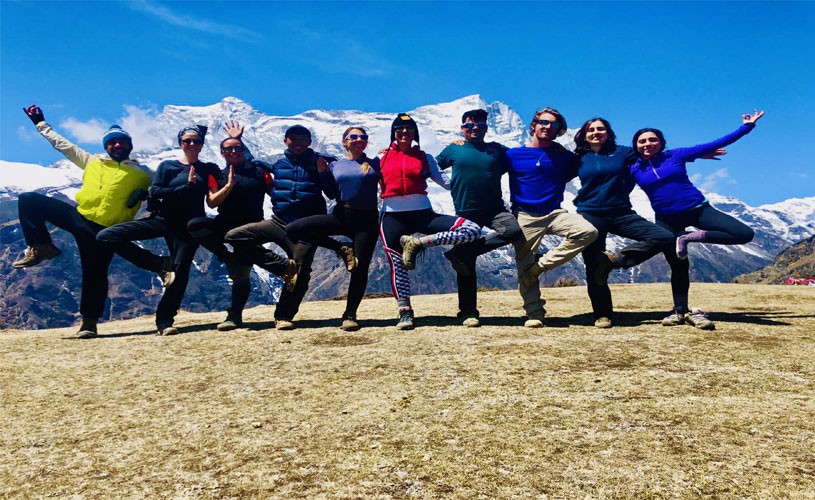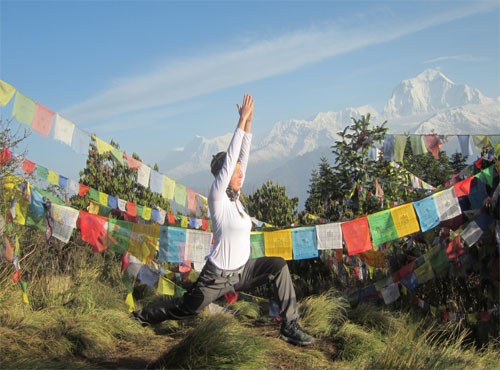Major Highlights of Everest Base Camp Yoga Trek
- Sightseeing in Kathmandu, including UNESCO World Heritage sites.
- Daily yoga and meditation sessions guided by an experienced Yoga Guru.
- Visit Namche Bazaar, the busiest market in the Everest region, and your first viewpoint of Mt. Everest.
- Witness majestic peaks like Mt. Everest, Nuptse, and Thamserku.
- Explore Tengboche Monastery, the largest monastery in the Khumbu region.
- Yoga sessions with stunning views of the monastery and surrounding mountains.
- Perform yoga poses at Everest Base Camp with views of the Khumbu Glacier.
- Experience a yoga session at Kala Patthar, offering the ultimate view of the Everest region.
- Scenic mountain flights to and from Lukla.
A Spiritual Journey with the Everest Base Camp Yoga Trek
Are you looking for a profound spiritual experience amidst the majestic Himalayan mountains? Do you seek an opportunity to immerse yourself in nature’s splendor while practicing yoga? The Everest Base Camp Yoga Trek in Nepal offers the perfect combination to rejuvenate your mind, body, and soul. This trek is designed for those who wish to explore cultural and natural wonders while embracing the essence of yoga in a serene mountain environment.
Yoga trekking is a harmonious blend of physical activity and spiritual awakening. By integrating yoga practice with trekking, it connects your inner self with the natural elements around you. This unique adventure revitalizes the senses, offering greater relaxation and heightened awareness. The benefits of yoga are immense—it enhances flexibility, strengthens muscles, reduces stress, and alleviates anxiety and back pain. It also improves sleep and overall mental well-being. Suitable for all age groups, yoga trekking is a rare opportunity to achieve sound health and peace of mind while exploring breathtaking landscapes.
Nepal, often regarded as the birthplace of yoga and meditation, provides an unparalleled setting for this spiritual journey. The Everest Base Camp region, with its pristine environment and awe-inspiring views, offers an extraordinary experience of practicing yoga under the shadow of the world’s highest peaks. Performing yoga in this sacred landscape is a transformative journey that rejuvenates the body, refreshes the mind, and nourishes the soul, making it an unforgettable adventure.
What is Yoga Trekking and Its Benefits?
The Everest Base Camp Yoga Trek combines physical fitness, mental peace, and spiritual awareness. Mountains have long been associated with divine energy, and trekking through the Himalayas allows you to tap into this natural source. Each day begins with yoga practice under the guidance of an experienced instructor, setting the tone for a day of trekking and exploration. Along the way, you’ll experience Nepal’s rich culture, stunning landscapes, and the warm hospitality of its people, creating a holistic spiritual adventure.
Your yoga trek begins in the ancient city of Kathmandu, a UNESCO World Heritage site known for its vibrant culture and historical significance. After exploring the cultural landmarks of the Kathmandu Valley, you’ll head to the Everest region. Here, each day of the trek starts with yoga and meditation, allowing you to connect deeply with the serene mountain environment. Guided by an expert team, you’ll traverse diverse landscapes and encounter the unique flora and fauna of the Himalayan ecosystem.
Conclude Your Journey with Lasting Memories:
The 16-day trek offers an immersive experience, culminating in a visit to the iconic Everest Base Camp. Along the way, you’ll enjoy breathtaking views of the Himalayan peaks, including the panoramic vistas from Kala Patthar. As the trek concludes, you’ll return to Kathmandu via a scenic flight from Lukla, cherishing the memories of your spiritual and adventurous journey. The Everest Base Camp Yoga Trek is a once-in-a-lifetime experience that combines physical challenge, spiritual awakening, and natural beauty in the heart of the Himalayas.
How Difficult is the Everest Base Camp Yoga Trek?
The Everest Base Camp Trek may seem challenging, but it is achievable with proper planning and determination. Thousands of trekkers from around the world complete it each year. The trek involves walking 5-6 hours daily, typically starting at 8 AM and finishing around 3 PM, depending on the day’s destination. The trail varies in terrain, offering stunning panoramic views of the Everest region that make the effort worthwhile. While the trek requires physical and mental preparation, with the right mindset and determination, most individuals can complete it.
What is the Best Time for the Everest Base Camp Trek?
The ideal times for the Everest Base Camp Trek are spring (March to May) and autumn (September to November). During these seasons, the weather is generally clear, offering spectacular Himalayan views. Daytime temperatures are mild, though nights can be cold. In spring, Namche Bazaar (3,440 meters) sees temperatures of 3-9°C (37-48°F), while autumn nights can dip below freezing, though daytime trekking remains comfortable.
Winter (December to January) offers a more adventurous experience, with daytime temperatures often below freezing and snowfall expected as far as Lukla. These months are great for avoiding crowds, but the trek becomes more challenging. The monsoon season (June to August) is considered off-season for the Everest Base Camp trek due to heavy rainfall, but lower-altitude treks in the Khumbu region remain possible.
Meals on the EBC Yoga trek:
All meals — breakfast, lunch, and dinner — will be provided during the trek, and breakfast will only be provided in Kathmandu. We host welcome and farewell dinners for our guests. During the trek, we have breakfast and dinner at tea houses or lodges where we spend nights while there will be lunch at tea houses on the way. You have the option to choose from Nepali, continental, Tibetan, and Indian cuisines. As we take care of our guests, we ensure that you are getting healthy food. We prioritize locally produced organic food and also provide you with seasonable fruits. During the climbing session, hygienic, freshly cooked food will be provided.
Note: If you are a vegetarian, let us know in advance so that we can make proper arrangements for food as per your wish during the trek
Accommodation on the EBC Yoga trek:
You will be accommodated in a three-star standard hotel in Kathmandu and a guesthouse/teahouse during the trek. All accommodations are on a twin-shared basis. A single supplement will be served on request and will cost an additional. Adventure Club Trek will arrange rooms with attached washrooms; however, teahouses in some places only have shared washing and toilet facilities. Also, note that single rooms are readily available in Kathmandu and the trekking regions at lower altitudes but, it might be complicated to find them at higher altitudes.
Drinking Water on the EBC Yoga trek:
Adventure Club provides all the meals on the trek but doesn't provide water. The best option is to treat the local water either with chlorine/iodine tablets or a steripen. The tea houses will give you good quality free water and, you can also get along the trail but, you will need to treat it. If you are using the tablets make sure they dissolve completely (about 30 mins). On most treks, you can buy mineral water along the trail. A liter of mineral water at lower-elevation tea houses costs around USD 1 but at higher elevations can cost up to $4 so the cost can add up.





